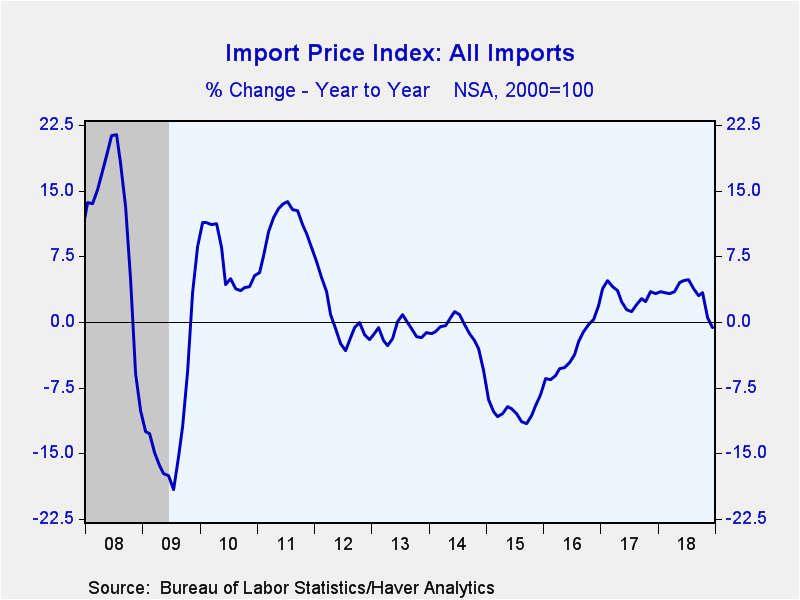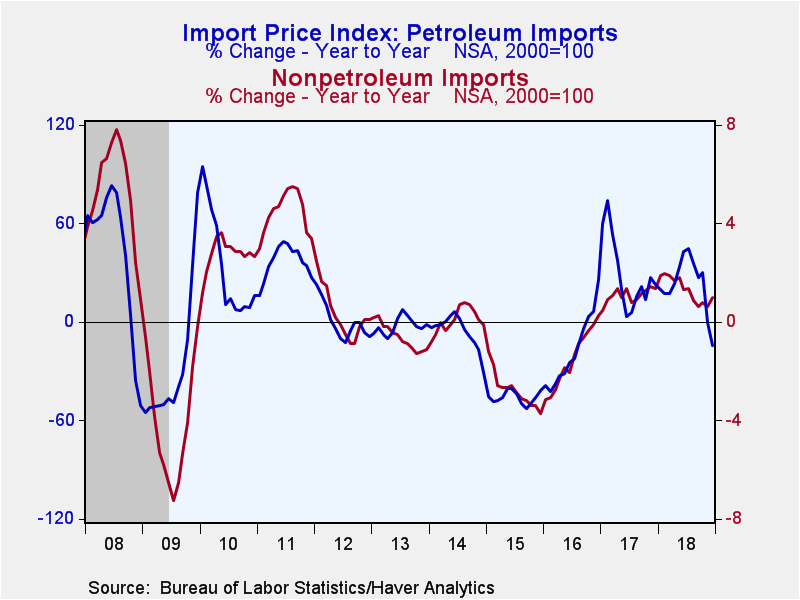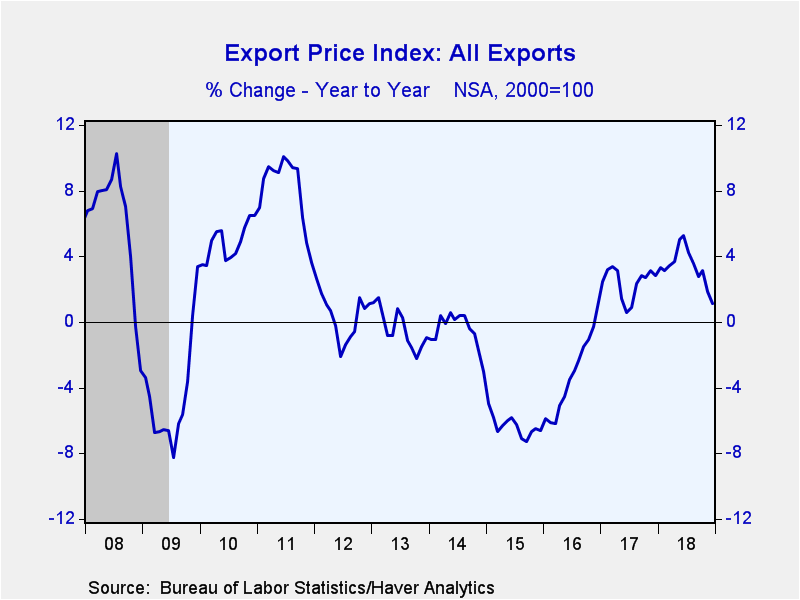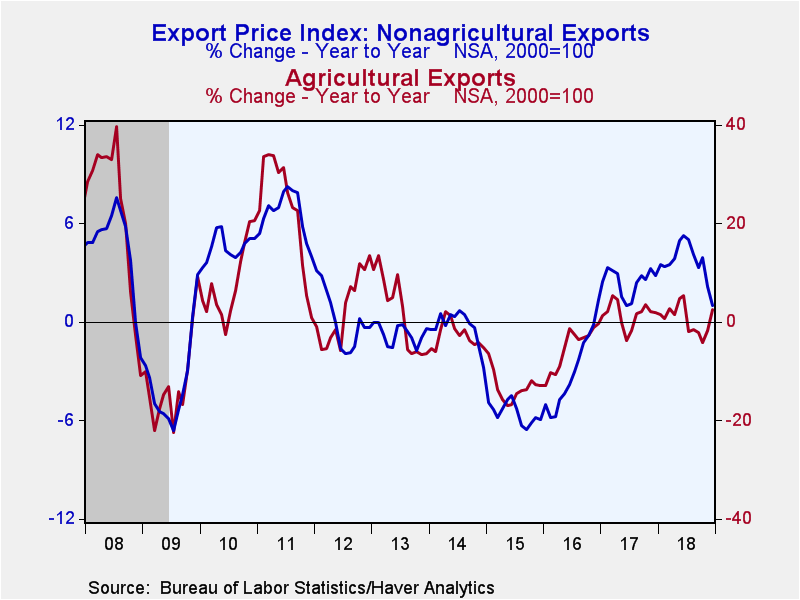 Global| Jan 16 2019
Global| Jan 16 2019U.S. Import Prices Pulled Lower by Falling Oil Prices
by:Tom Moeller
|in:Economy in Brief
Summary
Import prices fell 1.0% during December following a 1.9% November decline, revised from -1.6%. A 1.3% fall had been expected in the Action Economics Forecast Survey. During all of 2018, import prices fell 0.6% from December-to- [...]
Import prices fell 1.0% during December following a 1.9% November decline, revised from -1.6%. A 1.3% fall had been expected in the Action Economics Forecast Survey. During all of 2018, import prices fell 0.6% from December-to-December. These figures are not seasonally adjusted.
The decline in import prices last month was led by an 11.6% drop (-14.0% y/y) in petroleum import costs which followed a 16.0% fall. Nonpetroleum import prices increased 0.3% (1.0 y/y) during December after holding steady in the prior month. Industrial supplies & materials costs declined 3.9% (-3.1% y/y) with lower oil prices, as it followed a 6.2% fall. Industrial materials prices excluding petroleum strengthened 1.5% (5.1% y/y) after a 1.4% rise. Capital goods prices eased 0.1% (-0.2% y/y) for a second straight month. Motor vehicle & parts prices improved 0.1% (0.3% y/y) and reversed the November dip. Nonauto consumer goods prices rose 0.1% (0.6% y/y) following no change in the prior month.
Export prices declined 0.6% during December after a 0.8% decline, revised from -0.9%. A 0.7% decline in prices had been expected. During all of last year, export prices rose 1.1% from December-to-December.
Agricultural commodities prices increased 3.9% last month (2.5% y/y) after rising 1.7% in November. Nonagricultural product costs declined 1.1% (+1.0% y/y), about the same as in November. Foods, feeds & beverage prices surged 3.9% (2.8% y/y) following a 1.9% gain. The cost of industrial supplies & materials weakened 3.2% (+1.0% y/y) after falling 2.8%. Excluding fuels & building materials, these prices fell 0.9% (+1.9% y/y). Capital goods prices held steady (1.2% y/y) for the third month in the last four. Motor vehicle & parts prices improved 0.1% (0.9% y/y) and have been little changed for five consecutive months. Nonauto consumer goods prices also ticked 0.1% higher (0.3% y/y) after holding fairly steady since February.
The import and export price series can be found in Haver's USECON database. Detailed figures are available in the USINT database. The expectations figure from the Action Economics Forecast Survey is in the AS1REPNA database.
The Perplexing Co-Movement of the Dollar and Oil Prices from the Federal Reserve Bank of New York is available here.
| Import/Export Prices (NSA, %) | Dec | Nov | Oct | Dec Y/Y | 2018 | 2017 | 2016 |
|---|---|---|---|---|---|---|---|
| Imports - All Commodities | -1.0 | -1.9 | 0.5 | -0.6 | 3.1 | 2.9 | -3.3 |
| Petroleum & Petroleum Products | -11.6 | -16.0 | 2.9 | -14.0 | 22.1 | 26.6 | -19.7 |
| Nonpetroleum | 0.3 | 0.0 | 0.2 | 1.0 | 1.3 | 1.1 | -1.5 |
| Exports - All Commodities | -0.6 | -0.8 | 0.5 | 1.1 | 3.4 | 2.4 | -3.2 |
| Agricultural | 3.9 | 1.7 | -0.1 | 2.5 | 0.6 | 1.5 | -5.4 |
| Nonagricultural | -1.1 | -1.0 | 0.5 | 1.0 | 3.7 | 2.5 | -3.0 |
Tom Moeller
AuthorMore in Author Profile »Prior to joining Haver Analytics in 2000, Mr. Moeller worked as the Economist at Chancellor Capital Management from 1985 to 1999. There, he developed comprehensive economic forecasts and interpreted economic data for equity and fixed income portfolio managers. Also at Chancellor, Mr. Moeller worked as an equity analyst and was responsible for researching and rating companies in the economically sensitive automobile and housing industries for investment in Chancellor’s equity portfolio. Prior to joining Chancellor, Mr. Moeller was an Economist at Citibank from 1979 to 1984. He also analyzed pricing behavior in the metals industry for the Council on Wage and Price Stability in Washington, D.C. In 1999, Mr. Moeller received the award for most accurate forecast from the Forecasters' Club of New York. From 1990 to 1992 he was President of the New York Association for Business Economists. Mr. Moeller earned an M.B.A. in Finance from Fordham University, where he graduated in 1987. He holds a Bachelor of Arts in Economics from George Washington University.










